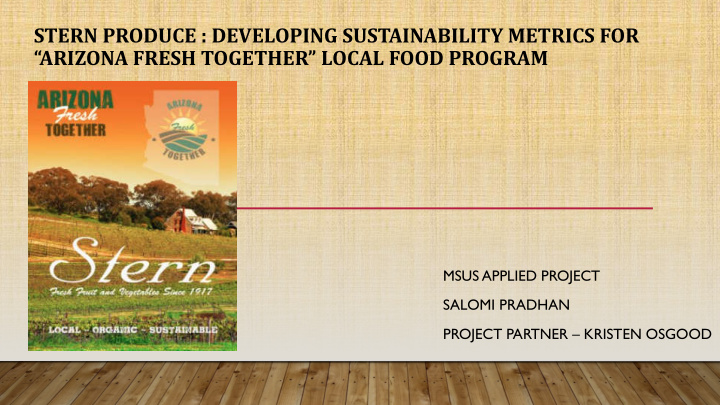



STERN PRODUCE : DEVELOPING SUSTAINABILITY METRICS FOR “ARIZONA FRESH TOGETHER” LOCAL FOOD PROGRAM MSUS APPLIED PROJECT SALOMI PRADHAN PROJECT PARTNER – KRISTEN OSGOOD
INTRODUCTION • Stern Produce Co . :A family owned food distribution business in Phoenix since 1917 • Committed to building partnerships with local farms in Arizona to meet the wholesale demand for Arizona grown food. • Embraced the responsibility to conduct business in a manner that invests in community wellness, fosters societal resilience and environmental health. • ARIZONA FRESHTOGETHER (AFT) : Revolutionize Arizona with local food supply chain partnerships
AFT : GOALS AND OBJECTIVES Help Stern Preserve our ARIZONA Produce, as a valuable farmlands, company, to gain FRESH unique biodiversity first mover and celebrate it TOGETHER advantage. Help protect Stimulate our our health as Support local local food well as the and often family economy health of our run smaller communities farms in AZ
AFT METRICS AND INDICATORS Ecosystem/ Economic Resilience/ Socio-cultural Food Safety & Food Nutrition Biodiversity Stability Stability Well being Farm Certification Sustainable Food affordability Human health & safety • • • • • Crop diversity farming practices • Creation of local job • Quality of life/wellbeing Crop Food Water usability opportunities Equity, Justice • • • • Pest Control • C02 emissions • Creation of secondary • Biological and cultural GMO/Non GMO Pest control economic opportunities diversity • • Food methods Stern local revenue Resiliency in the system • • • storage/processing • Soil health indicators/profitability • Happiness Food taste and margins in local food • enjoyment distribution
WHAT I DID … Environmental Researched and collected data of potential GHG emissions to compare the environmental implications of local VS conventional food sourcing . Economic Relied on survey questionnaires and informal • Social interviews with local Arizonian farmers Extensive literature review and stakeholder • engagement Human Health
ENVIRONMENTAL IMPLICATIONS CO2 emissions released in conventional sourcing of food produce from out of state of AZ CO2 emissions released in local sourcing of food produce from within the state of AZ
CONTINUED… • Farms are certified either Organic , GHP (Good Handling Practices) / GAP (Good Agricultural Practices) certified or Naturally Grown. • Strictly no use of any synthetic chemical inputs (e.g. fertilizers, pesticides, antibiotics, food additives) • None of the farms use genetically modified seeds • Use of sustainable farming practices like eliminating tillage, cover cropping, crop rotation, drip irrigation etc. • No chemical sprays for pest control • Water conservation strategies • Lesser environmental pollution • Greater accountability
ECONOMIC IMPLICATIONS • Stern’s Direct dollar value spent to the local providers/economy from 01/01/17 to 11/06/17 Stern’s sales data for local vs conventional food distribution for 1-1-17 to 11-6-17 is appx 1.3 million No of Cases Sold • Local farms projected a local sales revenue growth from in between 5% to 15% in the past 3-4 years 79182, 12% Conventional Farms Sales • The farmers that I interviewed employ an Local Farms Sales average of 30 to 50 people in their business in 572434, 88% the peak season. (production side) • Currently, it is out of the farmers’ budget and capacity to track how much are they contributing to the local economy of AZ.
SOCIAL IMPLICATIONS • Local farms GHP/GAP certified • Safety protocols priority, regular inspections and audits, rigorous employee trainings, instant reporting and feedback assessments • Workers wages above the state’s average wage rate (community healthcare, community housing) • Impressive biological and cultural diversity ratio. On average, every farm employed 30% women and 50% native Navajos and Latino workers • Strong community cohesion • Vulnerable and less resilient to shock strategies in case of natural calamities (hurricanes, floods, droughts), market crashes, social upheavals • Happiness is the key!
CONCLUSION Benefits of AFT Scope for Improvement to make AFT a viable success • AFT is a sustainable and successful food program • Local farms and farmers are not resilient enough The metrics created were well defined, meaningful, • Need for Education, policies & Incentives to drive local food • measurable, motivational and easy to understand and systems. communicate to all stakeholders Consumers must be willing to eat seasonally • • The metrics created will enable us to statistically • Heavy disparity and inconsistency issue with the supply and measure benefits of local food programs like the AFT demand side in the markets for local produce The project also provided a comprehensive assessment • Uncertainties around social characteristics of sustainability • of health, resilience, fairness and transparency that are • Lack of tracking or documentation of economic contribution not generally used in a typical supply chain analysis of local food systems to the local economy. • Social capital is as important as the economic capital!
CALL FOR ACTION… • Scope to actually forecast, measure and compare the results of the indicators with time as AFT program continues to generate more revenue and consequently affect lives of more people • The metrics I present can be used as a marketing tool for branding and marketing the AFT program to demonstrate the importance of local food systems
THANK YOU!
Recommend
More recommend